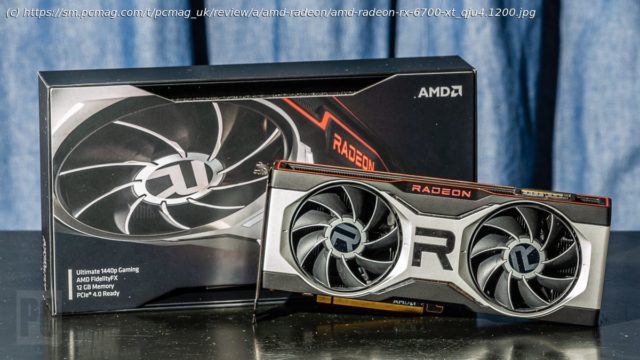Midrange Big Navi has muscle, but’s a bit of a bummer with older games
The launch of AMD’s new Radeon RX 6700 XT graphics card ($479.99) is a bit of a rerun, but of a so-so mid-1970s cop show: a story we’ve seen before, in an episode we were hoping we wouldn’t see again. To quote our earlier Radeon RX 6800 XT review: «This launch has been anything but smooth. Benchmarking took multiple days…just to come to the same conclusion: AMD’s driver support continues to be the company’s main weak spot. As an architecture, RDNA 2 holds a lot of promise both in PC and console, but as of today, that’s all we saw in the RX 6800 XT…a whole lot of promise, without consistent-enough results to back it up just yet.» Replace one number in that quote («7» for the «8»), and you’ve got your synopsis of the RX 6700 XT. Even though it’s been roughly four months since the launch of RDNA 2 (AMD’s latest architecture for Radeon gaming video cards), AMD’s robust, competitive hardware remains hampered by inconsistent driver support for certain games. This prevents the Radeon RX 6700 XT from attaining greatness in the midrange alongside Nvidia’s five-star GeForce RTX 3070 Founders Edition. Admittedly, the RTX 3070 is a scary competitor, and when the stars align, the RX 6700 XT is a fine card for the money for play at 1440p and 4K (depending on your detail level). But that’s only if the pieces fall into place for the specific games you play. That isn’t enough for us to strongly recommend the RX 6700 XT at its launch price (or anything higher, given where aftermarket video-card prices are headed these days), though with today’s card-supply situation, anything is better than nothing…right? Specs Compared: AMD Radeon RX 6700 XT vs. the World The new AMD Radeon RX 6700 XT is based on the company’s RDNA 2 architecture, and it features TSMC’s 7nm lithography on a 335mm2 «Navi 22 XT» GPU die. The card features 12GB of GDDR6 RAM, which looks pretty substantial compared with Nvidia’s GeForce RTX 3070 Founders Edition and its comparatively measly 8GB of GDDR6. In advertising this card, AMD is keen to point out particular games, such as Horizon Zero Dawn and Red Dead Redemption 2, which both can utilize more than 8GB of VRAM when set to their highest detail levels. This is perhaps a bit of flak to distract you from the areas where the RX 6700 XT trails the RTX 3070, like in ray-tracing cores, memory bandwidth speeds, bus size, and power consumption. On MSRP pricing, the RX 6700 XT snipes the RTX 3070 by $20…though, of course that’s a bit of a moot point in today’s scalper-dominated marketplace for video cards. Prices are essentially fluid unless you luck into a rare card available for an eyeblink on a reseller’s site. We tested the reference version of the RX 6700 XT, direct from AMD. Third-party sellers will have different designs. The dual-slot, dual-fan RX 6700 XT is 10.5 inches long, and it falls right within the compact tier of cards that are at the limit of what Mini-ITX PC builders might be able to fit in their next build. The RX 6700 XT maintains many of the same design elements we first saw when we reviewed the Radeon RX 6800 XT, while also bringing a few new accents to the table like a silver-on-red finish, and some more contouring around the fan openings. The 230-watt power requirement is within expectations for the midrange these days, as is the twin-power-connector layout found on top of the card. (You will need a six-pin and an eight-pin connector from your PSU.) AMD recommends at least a 650-watt PSU with the card. The backplane of the RX 6700 XT card contains what’s quickly become the standard lineup in the reference-card and Founders Edition card field: three DisplayPort 1.4b slots, one HDMI 2.1 port, and no VirtualLink to be found. Let’s Get Testing: DirectX 11? Never Heard of It! PC Labs ran the AMD Radeon RX 6700 XT through a series of DirectX 11- and 12-based synthetic and real-world benchmarks. Our PC Labs test rig is Intel-based and employs a PCI Express 3.0, not 4.0, motherboard. It’s equipped with an Intel Core i9-10900K processor,16GB of G. Skill DDR4 memory, a solid-state boot drive, and an Asus ROG Maximus XII Hero (Wi-Fi) motherboard. All cards below were tested on this rig. Given our tests with the Core i9-10900K and recent Ryzen 9 CPUs, this rig is the best reasonable configuration of the moment in 2021 to cut the CPU out of the equation for frame rates. (Read more about how we test graphics cards.) For our testing, we focused some of the effort on the esports aspect of the card with games like Counter-Strike: Global Offensive (CS:GO) and Rainbow Six: Siege. We also ran the card through the rest of our standard benchmark regimen, which tests a card’s abilities to handle AAA games at the highest possible quality settings, as well as how it rides during synthetic benchmarks that stress the card in a variety of ways. Also remember that almost every test we run (aside from the esports titles) is done at the highest possible quality preset or settings. If you have a higher-hertz gaming monitor and you’re worried your card might not make the frame-rate grade, it could still be possible with the right card and a combination of lower settings. Not only that, but some of these titles (including Death Stranding, Shadow of the Tomb Raider, and F1 2020) have both DLSS and FidelityFX CAS with Upscaling integrated directly into the game. This can mean boosts of up to 40% more performance on top, depending on the setting and the card you’re playing with. And so, onward to our test results. Note: If you want to narrow down our results below to a specific resolution (say, the resolution of the monitor you plan to game on), click the other two resolution dots in the chart legends below to suppress them and see a single set of results. Our list of AAA titles includes a mix of recent AAA titles like Red Dead Redemption 2 and F1 2020, as well as some older-but-still-reliable pillars of the benchmarker’s toolkit, like Shadow of the Tomb Raider and Far Cry 5. Testing Results: Synthetic Benchmarks Synthetic benchmarks can be good predictors of real-world gaming performance. UL’s circa-2013 Fire Strike Ultra is still a go-to as an approximation of the load levied by mainstream 4K gaming. We’re looking only at the test’s Graphics Subscore, not the Overall Score, to isolate the card performance. Meanwhile, we also ran 3DMark’s Time Spy Extreme test, which is a good test of how well a card will do specifically in DirectX 12 games at 4K resolution. We also run 3DMark’s Port Royal, strictly a test for GeForce RTX cards at the moment, measuring how well they handle ray-tracing tasks. (Thus the absent bars there for the AMD Radeon cards.) Also here are a pair of GPU-acceleration tests (Furmark, LuxMark); more details on those at the «how we test» link. The Radeon RX 6700 XT struggled to keep pace with the Nvidia RTX 3070 Founders Edition in these benches, not finding even a single win in any of the tests we run. Not only that, but it was substantially slower than the RTX 3070 in our Furmark run, a trend mirrored by the results of the RX 6800 and RX 6800 XT in the same test. Testing Results: Recent AAA Games Now on to the real-world game stuff. The following benchmarks are games that you can play. We typically used in each case (for the AAA games) the highest in-game preset and, if available, DirectX 12. The multiplayer-focused and esports titles (such as CS:GO and Rainbow Six) were set slightly below top detail settings to maximize frame rates. Straight out of the gate with our AAA games testing, we’re seeing a trend similar to that of the Radeon RX 6800 XT and RX 6800. As a DX11 game, Assassin’s Creed: Odyssey had similar stalling problems in 1080p and 1440p that we saw in that review; however, things picked up as we went down the line into more recent AAA titles based on DX12. In quite a few instances, the RX 6700 XT took a slight lead over the RTX 3070 Founders Edition, like in Shadow of the Tomb Raider in 1080p and almost every resolution of Total War: Warhammer II, as well as some resolutions of Far Cry 5, Metro Exodus, and Death Stranding. Overall, the card keeps pace with the RTX 3070 Founders Edition, trading blows in these new or new-ish AAA games, while also keeping enough space between itself and the RX 6800 to justify the gap in cost. This is when the RX 6700 XT is at its best: when it’s playing games that AMD has paid attention to.






